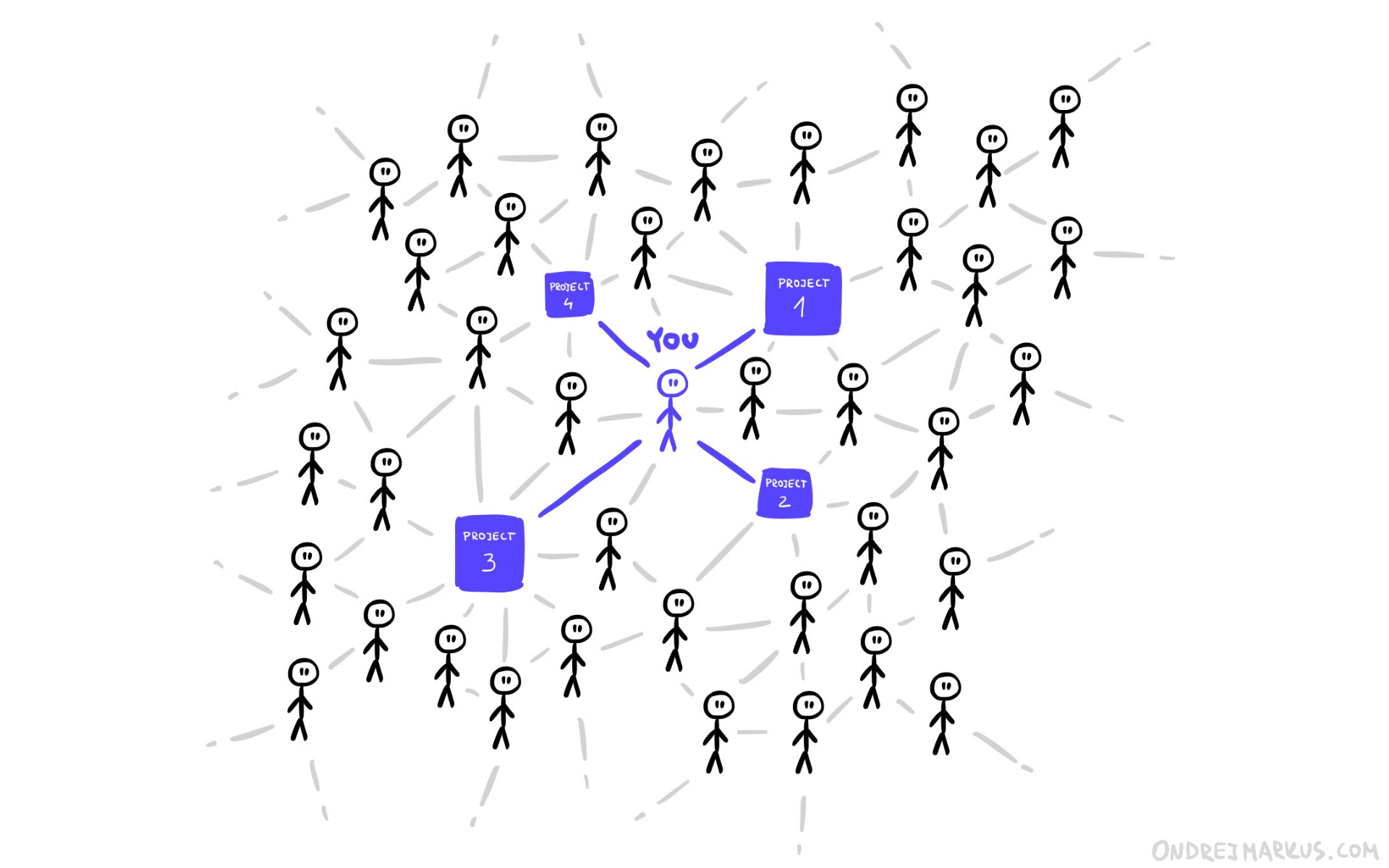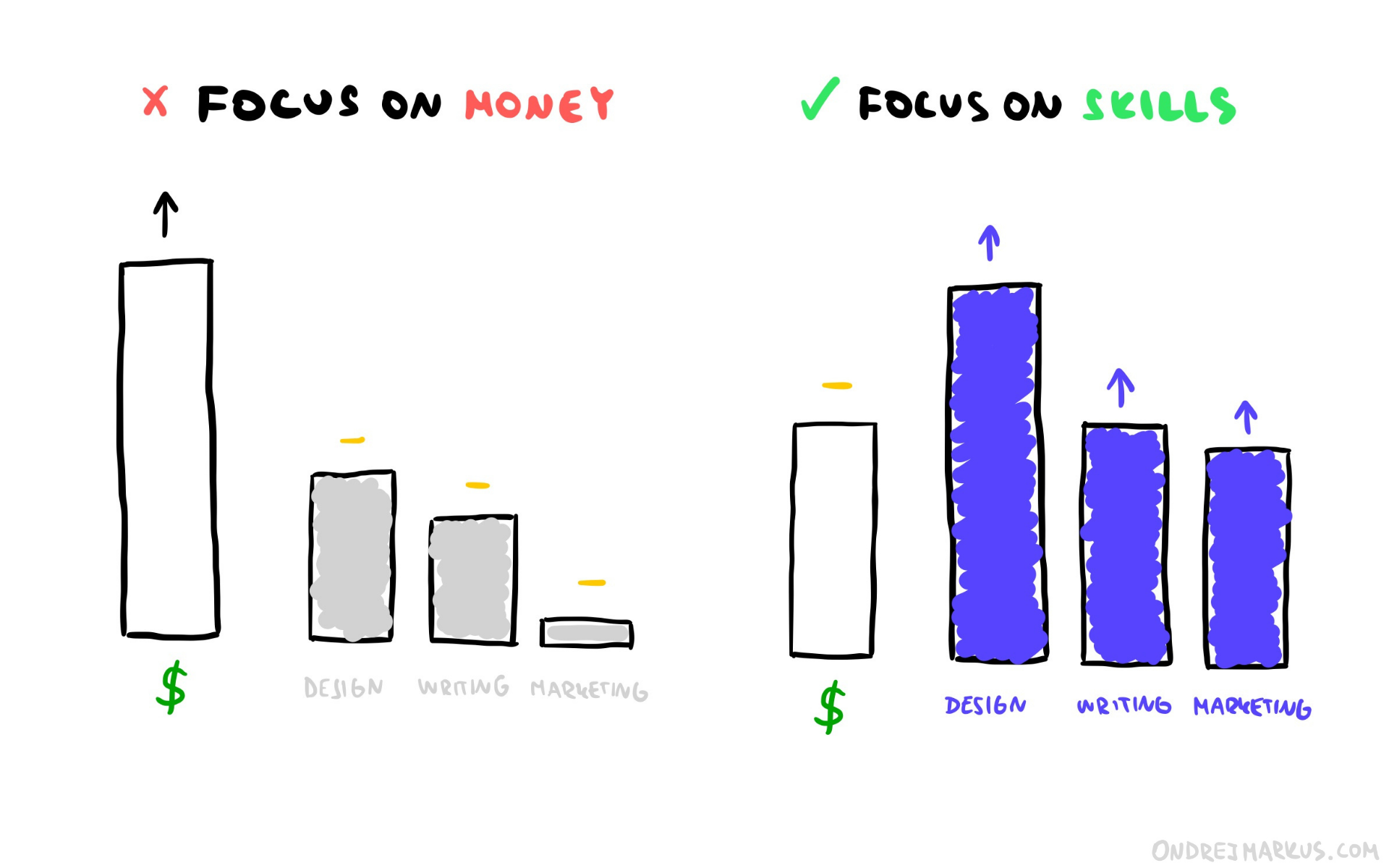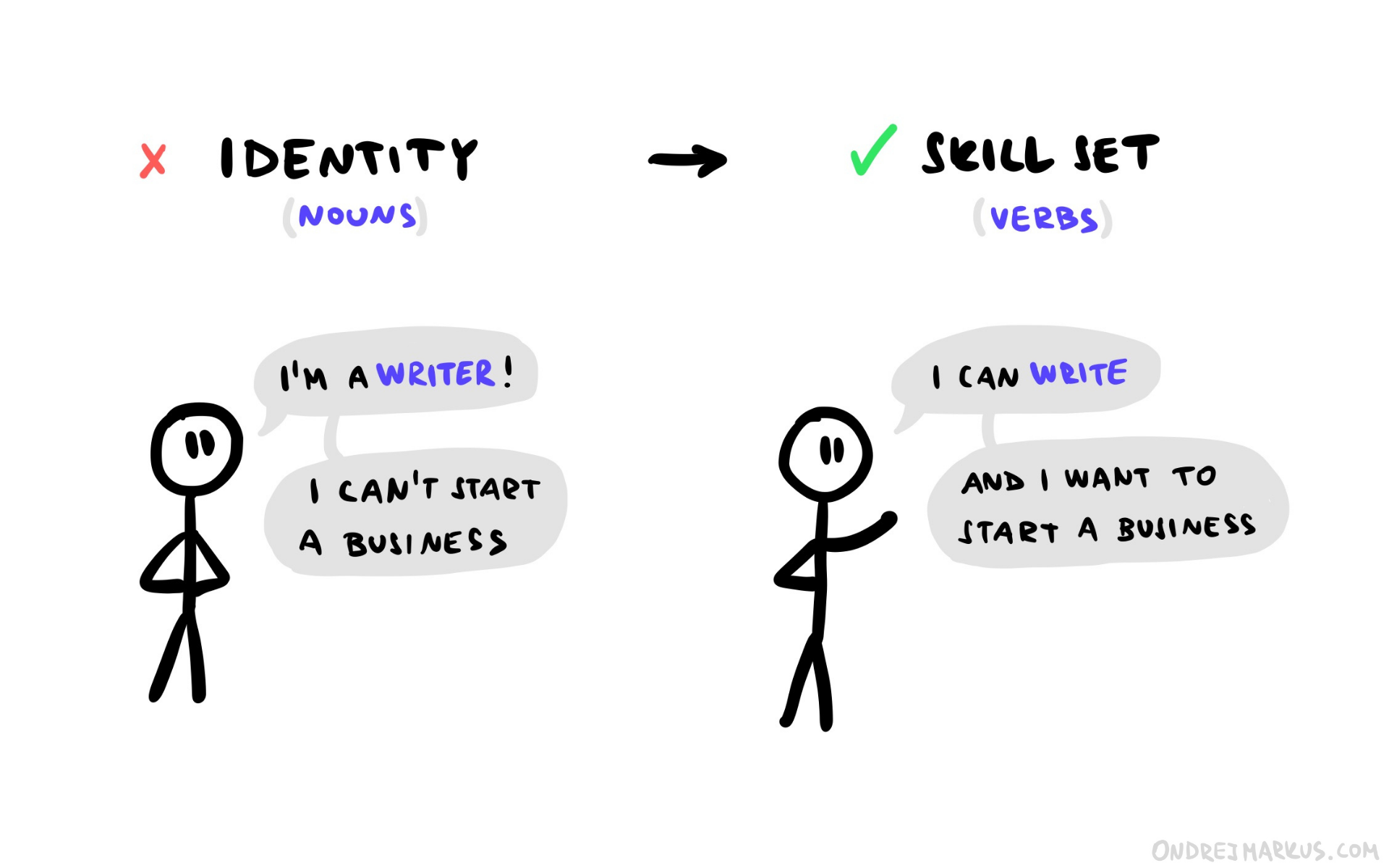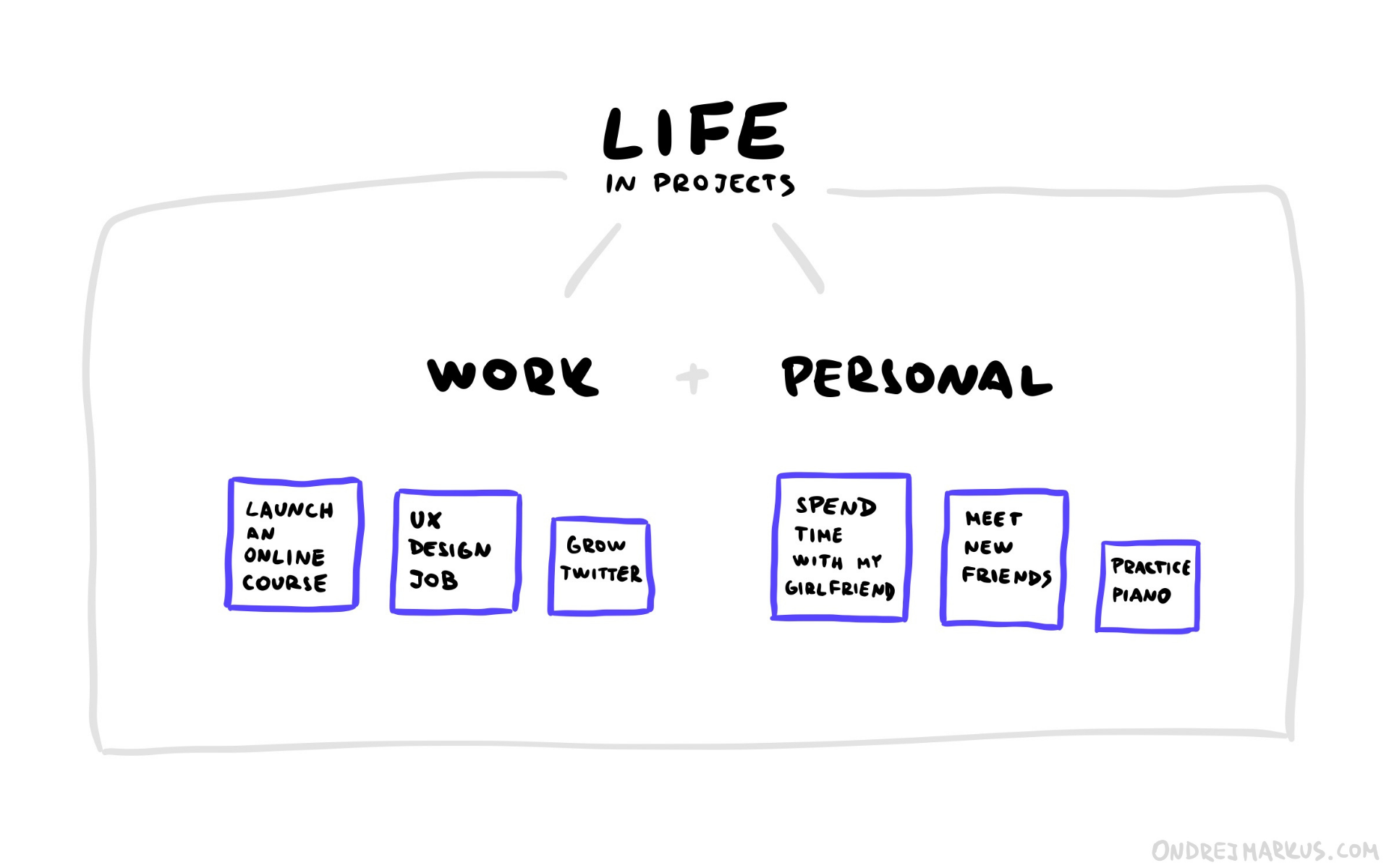Ondrej Markus
Entrepreneur in ed-tech, building the future of education as a founder and CEO at Playful.
I write about the future of education, designing learning games, and running a startup.
I'm a generalist, introvert, gamer, and optimizing to be useful.

The Full-Stack Freelancer – A new approach to work

Your work can be a source of financial freedom, everyday enjoyment, and opportunities to make the world a little better. Or it can be a burden you endure to make a living.
The goal of this article is to show you a new approach to achieving the first scenario.
But to get there, we need to rethink how we work.
Don’t get lost chasing the perfect job
You got a job you wanted.
You are enjoying every day, the money is good, and you like the people. The work is interesting, and you are learning like crazy. It feels amazing.
Then, in 3 months, you sober up a bit. The work is fine, but you are a fast learner. So you devoured new skills and knowledge, and now it’s getting repetitive. You want to learn more, but that’s not your job. Your job is to do the repetitive stuff.
You’d actually like to make some positive impact on the world, and that’s not happening right now.
After 6 months, things get worse. It’s not that the job or the people have changed — no, they are the same. You’ve changed. You’ve evolved.
And now it feels like the job is blocking your way – unnecessary meetings, routine tasks, and sitting at the office with nothing to do.
You feel guilty thinking it, but you’re ready to move on. But you don’t want to look like a quitter, so you forget it and keep pushing on.
In a year, you are either burned out doing what you don’t enjoy, or you muster enough courage to quit and find a better job. After all, one year doesn’t look that bad on a CV, right?
So, finally, you are free. And you get a new job you are excited about.
You are enjoying every day, the money is good, and you like the people. The work is interesting, and you are learning like crazy. It feels amazing.
Then, in 3 months, you sober up a bit.
Oh no, it’s happening again.
Be the designer of your work, not its victim
Whenever we hear a story like this, we tend to think, “Oh common, this is normal. You start something new, it’s exciting, and then it blends into your routine which is less enjoyable. That’s life.”
It’s not untrue.
But.
Work doesn’t need to be this way.
I believe there is a better approach to making work more enjoyable, productive, and meaningful.
This approach defines a new kind of worker called the Full-Stack Freelancer, which I first found in an article by Tiago Forte.
Who is the Full-Stack Freelancer?
He’s not a traditional freelancer who specializes in one skill and offers it as a service.
Let’s deconstruct the name:
Full-Stack = Having the skills and tools to build things from an idea to a finished product.
Freelancer = Acting as an independent agent who often works on many projects at once.
This combo makes the Full-Stack Freelancer an ideal way of working for generalists – people who don’t have just one interest but prefer to learn and work on a diverse range of things.
Also, seeing himself as an independent agent doesn’t prevent the Full-Stack Freelancer from getting a full-time job. He just doesn’t limit himself to this one job. He sees the job as one of his projects and works on other things as well.
The rest of this article is about how you can use the tools and mindsets of the Full-Stack Freelancer to make your work and life better.
Becoming the Full-Stack Freelancer
- Think in projects
- Run experiments
- Build a network
- Focus on learning
- Leverage technology
- Shift identities
- Design a lifestyle
Think in projects
Most people treat their work as one box — a job. And they depend on it for everything they need: money, personal growth, community, a sense of meaning, etc.
If they dislike or lose the job, that’s trouble. It’s their source of everything which makes them vulnerable to change.
The Full-Stack Freelancer thinks about his work as a portfolio of projects. He diversifies his time and energy into smaller projects running in parallel.

Organizing work into projects opens new possibilities.
He might be working a part-time job, building an online product, and making extra income selling his expertise as a freelancer. He does different things to create diverse streams of:
- Income (→ Financial freedom)
- Skills (→ Personal growth)
- Relationships (→ Network of trust)
- Contribution (→ Value for others)
Shifting his time between projects makes him flexible. He can more easily react to new opportunities without having to make drastic transitions – like changing his only job.
Example: My portfolio of projects (August 2021)
- Writing my blog: Skills, Network
- Running my online course: Income, Contribution
- Teaching a university seminar: Skills, Income
- Growing my Twitter: Network, Skills
- Designing an app UX for an agency: Income, Skills
Think about your work as a portfolio of projects, not one job.
Run experiments
We are afraid of making mistakes. In school, we learn to believe being wrong is something to be afraid of. But you can never do excellent work unless you’re willing to take the risk of being wrong.
That’s why the Full-Stack Freelancer treats his projects as experiments. Whenever she has an idea, she runs a test. And she tries a lot of different things because she knows most ideas fail.
It doesn’t matter. She only needs a couple of winners in her portfolio. So she uses what works and discards the rest.

Experiments help you test ideas before you fully commit to them.
This way, she reacts to opportunities faster than most people while taking less risk because she doesn’t commit herself fully until she sees the project is probably going to work.
Example: Developing a new course in 3 weeks
- This April, I had an idea for a writers course, but I was buried in other projects and didn’t know how it should work. So I ran an experiment. I made a simple website and I sent it to a few friends who wanted to write more.
- They sent me feedback, and I used it to improve the idea. I repeated this 3 times with different friends. And, in the third round, I started getting replies like “I want this. When does it start?”
- I knew I’m onto something. So I told my friends the course is happening: Weekly sessions for a month and the price is $50. 7 people enrolled and I ran the course.
- The whole process took just 3 weeks and just a few hours of work from having the idea to launching the course with 7 paying customers.
Try different things as experiments, use what works, and discard the rest. Repeat.
Build a network
The Full-Stack Freelancer creates synergy between his projects by weaving them into one network to exploit the network effect:
- Any asset he creates for one project gets used on other projects.
- Any skill he learns on one project gets used on other projects.
- Any customer from one project might buy from his other projects.
Every new asset, skill, and relationship strengthens his entire portfolio. This way, the success of one project increases the chance of success everywhere else.
The result is a growing network of symbiotic projects linked with people interested in what he has to offer.

Treat your work as a network of people and projects.
Example: Build an online home
- One simple thing you can do to start weaving your projects together is to build an online home – a website with links to all your projects. So whenever people want to find out more about you and your work, they discover all your other projects.
- This website is my online home connecting all my projects.
- Twitter is where I meet new people and expose them to my work by having this site in my bio.
Weave your projects and people into one network.
Focus on learning
We tend to underestimate the value of skills and hoard extra income instead.
There is nothing wrong with making money. But the Full-Stack Freelancer prioritizes skills over extra income because skills compound better than money.
Skills create actual economic freedom because skills stay with you even if you lose everything else. Your money-making ability is worth more than money in the bank.
You will never regret doing work where you learn a lot. You might regret doing work for money you didn’t really need.

Often it’s better to choose to learn more over getting extra income.
Example: Bootstrapping a business
When I was 19, I used all my savings (~$1000) to start my first business. It bankrupted in 6 months, but it was the best learning experience I ever had.
I chose a challenge with an unlimited learning potential rather than selling ice cream or guarding festival fences. Those jobs had nothing to offer me except extra cash I had no immediate use for. But the skills I gained building a business are timeless.
Example: Bootstrapping a business
- When I was 19, I used all my savings (~$1000) to start my first business. It bankrupted in 6 months, but it was the best learning experience I ever had.
- I chose a challenge with an unlimited learning potential rather than selling ice cream or guarding festival fences. Those jobs had nothing to offer me except extra cash I had no immediate use for. But the skills I gained building a business are timeless.
Invest your time into skills over extra income.
Leverage technology
Ignoring technology is like choosing not to use one of your senses. Owning a computer with an internet connection is a superpower most people overlook.
Technology is reshaping the world. Anyone can learn anything for free on the internet and start building things with a few clicks. An average-skilled individual can create a billion-dollar company from his couch while creating value for millions of people. How crazy is that?

Use technology as leverage for change in the world.
The Full-Stack Freelancer uses technology to maximize her potential. She automates things to make herself more productive and scale her impact. Her ability to leverage technology gives her unprecedented power.
Example: Social media
- I just started on Twitter a few months ago and my account was tiny (~100 followers), but I recently wrote a series of tweets that got some traction. In 3 days, 20.000 people saw it, 400 visited my profile, and 80 followed me. Just because I wrote and shared something useful.
- The next week it happened again. What is going to happen if I can do this every week?
Use technology to 1000x your productivity and impact.
Shift identities
When people get too attached to their job title, it makes them stuck.
It’s not their fault. Our culture defines us with job descriptions: “Who are you?”, “I’m a designer. I’m a journalist. I’m a doctor.”
We pick a label and get stuck with it.

Think about work in verbs rather than nouns.
The Full-Stack Freelancer doesn’t attach his identity to one job title. He has many projects with different identities to keep his options open. He might be a part-time dentist, who also designs medical equipment, who also writes fiction books.
Not tying his identity to one project makes him free to take on new opportunities and adapt to a changing environment.
Example: Shifting work identity
- My work identity shifts often. Over 10 years, I was a freelance graphic designer, entrepreneur, project manager, game designer, CEO founder, innovation designer, UX designer, teacher, and writer.
- Once I stopped playing status games, I understood these labels represent skill-sets more than anything else. And that’s why I prefer to describe my work identity with verbs, instead of nouns: “I make things to help people design a better life.”
Keep your identity open to new opportunities.
Design a lifestyle
When people focus only on work, it breaks the other areas of their life. Neglecting health, friends, family, or hobbies, catches up with them and makes them unhappy.
The Full-Stack Freelancer applies her portfolio thinking not just to work, but to her personal life too. She avoids workaholism and burnout by including personal life goals in her projects.
So if she wants to have a satisfying relationship, start a family, or have a hobby, she makes sure it gets enough attention. She’s not just designing her work, she’s designing a life she enjoys living.
She often asks herself: “How do I want to spend my days?” And wraps her work around a lifestyle she enjoys.

Design a life you enjoy living.
Example: Designing my lifestyle
- My energy peak is in the morning, and I prefer working alone. So I have a rule: No meetings before noon. I don’t pick up the phone, do emails, or schedule meetings until 12 am. I protect my prime time.
- I chose projects where I don’t have to meet people often, so my calendar is empty. I spend 3/4 of my time doing deep work I enjoy.
- I make just enough money to make a living (~$1000/m) while optimizing for learning (writing, storytelling, design, marketing) and building projects with passive income.
- I make enough time in my week to meet friends, exercise, play games, and spend time with my girlfriend. (I have active projects for all of these.)
- But everyone prefers a different lifestyle. So my point isn’t that you should live more like me. Not at all. It’s that you should find a design that works for you.
Design your work around a lifestyle you enjoy.
What’s the next step?
These principles can feel overwhelming. So if you like this approach and want to use it in your life, start with this:
Take 20 minutes to think about your work as a portfolio of projects. Type, use an excel sheet or draw it on paper – whatever works best for you.
- Write down every project you’re working on – anything you spend your time on and is related to work: Your job, business, side projects, school, courses, blogs, social media, etc.
(Tip: If you have a full-time job, try dividing it into more projects. For example: Managing social media, designing graphics, writing PR articles.)
- Analyze every project individually and ask: What makes this project worth my time? Look for streams of income, skills, relationships, and contribution.
- Think about what you could change to create a balance of income, skills, relationships, and contribution, that works best for you.- What would you like to remove or do less?- What would you like to add or do more?
This will give you specific ideas on how to improve your work.